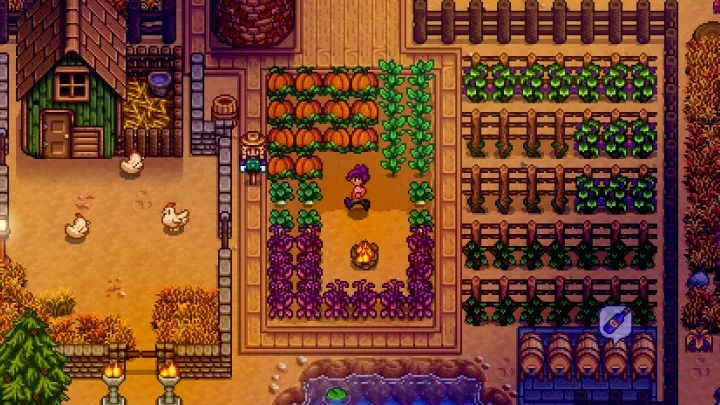Stardew Valley is a captivating farming simulation game developed by ConcernedApe, where players inherit a dilapidated farm in the charming town of Pelican Town. The game combines elements of farming, crafting, mining, and social interaction, allowing players to create their ideal rural life. With its pixel art graphics and soothing soundtrack, Stardew Valley offers a relaxing yet engaging experience. This guide will provide essential strategies, tips, and insights to help you master Stardew Valley, ensuring you make the most of your time on the farm.
Getting Started
As a new player, establishing a solid foundation in Stardew Valley is essential for long-term success. Here’s how to begin your journey.
Understanding the Basics
Upon starting the game, you’ll be greeted with a brief introduction and the opportunity to customize your character. Once you enter your farm, take some time to familiarize yourself with the layout and your initial resources. You’ll have a small plot of land with basic tools, including a hoe, watering can, axe, and pickaxe.
Setting Goals
Before diving into farming, it’s important to set some initial goals. Decide what you want to focus on first: crops, livestock, crafting, or social relationships. Having clear objectives will help you prioritize your activities and make the most of each day.
Exploring Pelican Town
Take some time to explore Pelican Town and meet the locals. Building relationships with residents can unlock new quests, recipes, and rewards. Visit shops, attend festivals, and engage in conversations to learn more about the town and its inhabitants.
Farming Fundamentals

Farming is at the heart of Stardew Valley, and mastering the basics will set you up for success.
Choosing Your Crops
In the early game, focus on crops that provide a good return on investment. Some of the best crops to plant in Spring include:
- Strawberries: High profit and regrow after harvesting.
- Cauliflower: Large yield with a good selling price.
- Potatoes: Chance to yield multiple potatoes per harvest.
Make sure to check the calendar for seasonal crops, as each season has its own unique plants.
Preparing the Soil
To plant crops, you must first prepare the soil. Use your hoe to till the land, making sure to leave space between crops for optimal growth. Remember to water your crops daily to ensure they thrive. Investing in sprinklers later on can automate this process.
Managing Your Time
Each in-game day has a limited amount of time. Plan your activities to maximize productivity. A good rule of thumb is to spend the first part of the day watering and tending to crops, then explore or engage in other activities in the afternoon.
Crafting and Upgrading
Crafting is a crucial aspect of Stardew Valley that allows you to create tools, machines, and other useful items.
Crafting Essentials
As you gather resources, focus on crafting essential items such as:
- Scarecrows: Protect your crops from crows.
- Storage Chests: Organize your items and resources.
- Furnaces: Smelt ores and create bars for crafting and upgrades.
Keep your crafting menu open and experiment with different recipes as you collect materials.
Upgrading Tools
Upgrading your tools is vital for improving efficiency on your farm. Visit Clint, the blacksmith, to upgrade your tools using ores. Prioritize upgrading your axe and pickaxe to gather resources more quickly. A higher-level watering can will also save you time during the growing season.
Building Farm Structures
Once you have a stable income, consider investing in farm buildings. Structures such as barns and coops allow you to raise animals, while a greenhouse lets you grow crops year-round. Plan your layout carefully to create an efficient and aesthetically pleasing farm.
Mining and Resource Gathering
Mining and resource gathering are essential for crafting and upgrading in Stardew Valley.
Exploring the Mines
The mines are located in the northeast corner of the map. As you venture into the mines, you will encounter various ores, gems, and monsters. Equip yourself with a pickaxe and be prepared for combat. The deeper you go, the better the resources you’ll find.
Gathering Resources
Focus on gathering essential resources such as:
- Copper: Used for tool upgrades and crafting.
- Iron: Required for advanced upgrades and crafting.
- Gold: Valuable for high-level crafting and selling.
Be sure to bring food and weapons to sustain yourself during your mining expeditions.
Using Bombs
As you progress, you can craft bombs to clear out large areas of rocks and ores quickly. Use bombs strategically to save time while mining and to defeat groups of enemies.
Fishing and Foraging
Fishing and foraging are excellent ways to diversify your income and gather resources.
Fishing Basics
Fishing can be a relaxing and profitable activity. Equip your fishing rod and head to any body of water. Each season offers different fish, so pay attention to the fish you catch and their availability. Some valuable fish include:
- Salmon: Available in Fall and can be sold for a good price.
- Sturgeon: Can be caught in the mountain lake and is valuable for crafting caviar.
Crafting Bait
Crafting bait can increase your chances of catching fish. Use bug meat to create bait and attach it to your fishing rod. Experiment with different fishing spots and times to maximize your catch.
Foraging for Wild Items
Foraging allows you to collect wild items such as berries, mushrooms, and flowers. These items can be used in cooking, given as gifts, or sold for extra income. Always keep an eye out for forageable items while exploring the map.
Building Relationships
Building relationships with the townsfolk is an integral part of Stardew Valley that can enhance your gameplay experience.
Interacting with Villagers
Make it a habit to talk to the residents of Pelican Town daily. Each character has unique preferences, stories, and events. Engaging in conversations can strengthen your relationships and unlock new quests.
Gift Giving
Gifting items to villagers is a great way to improve your friendship levels. Pay attention to each character’s likes and dislikes to maximize the effectiveness of your gifts. Some great gifts include:
- Fruits and vegetables: Generally liked by most.
- Artisan goods: Such as honey or wine, which are often appreciated.
Attending Festivals
Participating in seasonal festivals is another excellent way to build relationships. These events often include mini-games, food, and opportunities to interact with villagers. Winning competitions can yield valuable rewards and increase your friendship with the townsfolk.
Managing Your Farm
Proper farm management is crucial for optimizing productivity and efficiency.

Crop Rotation
Implementing crop rotation can help maximize your farm's productivity. Each season has specific crops, and rotating them can prevent soil depletion and improve yield. Plan your planting schedule in advance to ensure a steady income.
Animal Care
If you decide to raise animals, prioritize their care. Feed them daily, pet them, and provide shelter to keep them happy. Happy animals produce higher-quality products, such as milk and eggs. Consider investing in a barn and coop to house your livestock.
Automating Tasks
As your farm grows, consider investing in sprinklers, automatic feeders, and other tools to automate daily tasks. This will save you time and allow you to focus on other activities, such as mining or fishing.
Expanding Your Farm
As you progress in Stardew Valley, expanding your farm can lead to new opportunities and income.
Unlocking New Areas
Explore the surrounding areas to unlock new locations, such as the beach, desert, and forest. Each area offers unique resources, animals, and opportunities for farming and foraging. Expanding your territory can enhance your gameplay experience.
Crafting Artisan Goods
Creating artisan goods can significantly increase your profits. Invest in crafting machines such as:
- Kegs: For brewing beer and wine.
- Preserves Jars: For turning fruits and vegetables into preserves.
- Cheese Press: For making cheese from milk.
These products often sell for much higher prices than their raw ingredients.
Planning Future Seasons
Always plan ahead for the upcoming seasons. Stockpile seeds, craft necessary items, and ensure you have enough resources for your farm’s growth. Preparing in advance will make the transition between seasons smoother and more efficient.
Engaging in Community Projects
The community center is a central aspect of Stardew Valley that encourages players to engage in various activities.
Completing Bundles
The community center features bundles that require specific items to unlock rewards. These bundles encourage exploration, foraging, and crafting. Completing these bundles can yield valuable rewards, including new buildings and items.
Joining the Joja Mart Route
Alternatively, you can choose to support Joja Mart by completing their community development goals. This route offers a different experience and allows for unique gameplay opportunities. Weigh the pros and cons of each route based on your playstyle.
Collaborating with Villagers
Engaging with villagers to complete bundles fosters a sense of community. Attend events and support local projects to enhance your relationships and contribute to the town’s growth.
Conclusion
Mastering Stardew Valley involves a blend of farming, crafting, social interaction, and exploration. By understanding the game mechanics, developing effective strategies, and adapting to challenges, you can enhance your gaming experience and thrive in this charming world. Embrace the journey, experiment with different tactics, and enjoy building your ideal farm.
Summary:
This guide provides essential strategies for mastering Stardew Valley, focusing on farming techniques, crafting, relationships, and community engagement. With these tools, you'll be well-equipped to conquer the challenges ahead and enjoy everything Stardew Valley has to offer

















